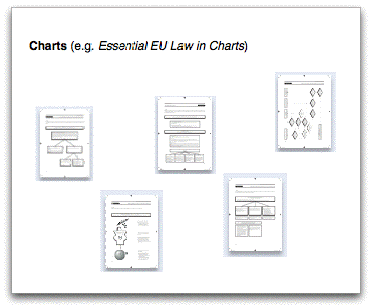Understanding the Charts method
In a changing world, teaching and knowledge sharing methods must cater for new generations’ needs:
- Generation Internet: The “internet-generation” expects to find the most relevant information on one single page and then to follow hyperlinks to suit individual needs.
- Generation iPod: Students of the “iPod-generation” are used to exercise control through hierarchic menus and thus understand and memorise graphic structures faster than mere texts.
- Generation Executive summary: The business community expects short and concise documents which easily present the most relevant information (+ organigrammes and excel charts).
- Generation Global village: Graphic representations use less language and are therefore more suitable to use for cross-border communication.
In view of the above, EUR-Charts gives you some idea of what the blueprint of the edifice of Union law would look like. Not unlike architecture, the basic concepts seem misleadingly simple. The challenge lies in making the right connections.
Two branches: the “Chart” branch and the “Text” branch. What’s the difference?
Textbooks on EU law often consist of several hundred pages, in some cases even of more than a thousand pages. This is too much in particular for beginners in EU law as well as for students from fields other than law who study EU law. With this group in view, the project team prepares comparatively short texts on the most important matters covered by the charts. The texts differ from other “nutshell” texts on EU law in that they are “linked” to the charts, i.e. the text contains the references to the charts that are relevant in the context of the subject matter discussed. In this way, the charts and the text can be used together.
The Charts method adopts a modular approach. It thus allows the use of the same materials side-by-side across a broad range of studies.
Suggested use:
| “Charts” + “Text” branches combined | “Charts” branch only | “Text” branch only | |
| Advanced students in EU law | • • • | • • • | • |
| Advanced law students | • • • | • • • | • |
| Undergraduate law students | • • • | • • (for specific fields) | • • |
| Non-law students | • • • | • • (for specific fields) | • • |
| Teachers pursuing continued education | • • • | • • | • |
| Teachers preparing courses | • • • | • • | • |
| Professionals pursuing continued education | • • • | • • | • • |
| Professionals instructing clients | • • • | • • • | • |
- Learn more about the Project’s background in the document BasicConcepts_EUR-Charts_1.0.ppt.pdf
- Download Flyer
- View Animation:
